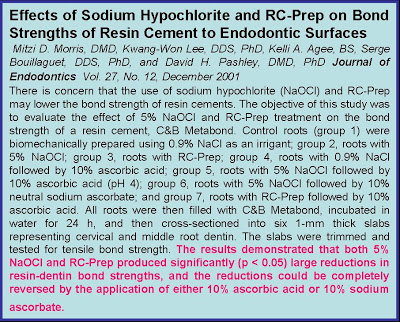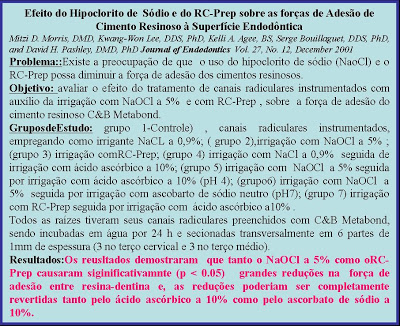Tudo Mais


- Biocompatibilidade De Diferentes Adesivos À Base De Cianoacrilatos
In vivo qualitative analysis of the biocompatibility of different cyanoacrylate-based adhesives. MORETTI NETO, Rafael Tobias; MELLO, Isabel; MORETTI, Ana Beatriz da Silveira et al. Braz. oral res., Jan./Mar. 2008, vol.22, no.1, p.43-47. Abstract:Cyanocrylates...
- Avaliação Clínica De Três Agentes Dessensibilizantes No Alívio Da Hipersensibilidade Dentinária
Clinical evaluation of three desensitizing agents in relieving dentin hypersensitivity.Oper Dent. 2007 Nov-Dec;32(6):544-8.Pamir T, Dalgar H, Onal B. Ege University, School of Dentistry, Department of Restorative Dentistry and Endodontics, Izmir, Turkey....
- Resumo Artigo :restauraÇÃo Na Endodontia
Biomechanical considerations for the restoration of endodontically treated teeth: a systematic review of the literature, Part II (Evaluation of fatigue behavior, interfaces, and in vivo studies).Quintessence Int. 2008 Feb;39(2):117-29 Dietschi D, Duc...
- Penetração Bacteriana Através De Diferentes Cimentos Endodônticos Quando A "smear Layer" é Removida Ou Não.
Bacterial penetration along different root canal filling materials in the presence or absence of smear layerInternational Endodontic Journal Volume 41 Issue 1 Page 32-40, January 2008Authors: I.M. Saleh( Faculty of Dentistry, University of Oslo, Oslo,...
- Endodontia MaceiÓ : Relato De Caso ClÍnico Ufal (everane Cristina)
_______________________(Figura do Caso)______________________RELATO DO CASO: Paciente M.C.C., 28 anos, procurou o serviço de Endodontia da FOUFAL com o objetivo de concluir um tratamento endodôntico que havia sido iniciado há um ano atrás. Durante...
Tudo Mais
Ácido Ascórbico e Ascorbato de Sódio X Materiais Adesivos


REVERSAL OF COMPROMISED BONDING IN BLEACHED ENAMELRESEARCH REPORTS
Biomaterials & Bioengineering
Biomaterials & Bioengineering
S.C.N. Lai1, F.R. Tay1*, G.S.P. Cheung1, Y.F. Mak1, R.M. Carvalho2, S.H.Y. Wei1, M. Toledano3, R. Osorio3, and D.H. Pashley4.Reversal of Compromised Bonding in Bleached Enamel J Dent Res 81(7):477-481, 2002
1Conservative Dentistry, Faculty of Dentistry, University of Hong Kong, Prince Philip Dental Hospital, 34 Hospital Road, Hong Kong, SAR, China; 2Bauru School of Dentistry, University of São Paulo, Brazil; 3Department of Dental Materials, University of Granada, Spain;and4Department of Oral Biology and Maxillofacial Pathology,
School of Dentistry, Medical College of Georgia, Augusta, GA, USA; *corresponding author, [email protected]
ABSTRACT
Oxygen inhibits polymerization of resin-based materials. We hypothesized that compromised bonding to bleached enamel can be reversed with sodium ascorbate, an anti-oxidant. Sandblasted human enamel specimens were treated with distilled water (control) and 10% carbamide peroxide gel with or without further treatment with 10% sodium ascorbate. They were bonded with Single Bond (3M-ESPE) or Prime&Bond NT (Dentsply DeTrey) and restored with a composite. Specimens were prepared for microtensile bond testing and transmission electron microscopy after immersion in ammoniacal silver nitrate for nanoleakage evaluation.
1Conservative Dentistry, Faculty of Dentistry, University of Hong Kong, Prince Philip Dental Hospital, 34 Hospital Road, Hong Kong, SAR, China; 2Bauru School of Dentistry, University of São Paulo, Brazil; 3Department of Dental Materials, University of Granada, Spain;and4Department of Oral Biology and Maxillofacial Pathology,
School of Dentistry, Medical College of Georgia, Augusta, GA, USA; *corresponding author, [email protected]
ABSTRACT
Oxygen inhibits polymerization of resin-based materials. We hypothesized that compromised bonding to bleached enamel can be reversed with sodium ascorbate, an anti-oxidant. Sandblasted human enamel specimens were treated with distilled water (control) and 10% carbamide peroxide gel with or without further treatment with 10% sodium ascorbate. They were bonded with Single Bond (3M-ESPE) or Prime&Bond NT (Dentsply DeTrey) and restored with a composite. Specimens were prepared for microtensile bond testing and transmission electron microscopy after immersion in ammoniacal silver nitrate for nanoleakage evaluation.
Bond strengths of both adhesives were reduced after bleaching but were reversed following sodium ascorbate treatment . Resin-enamel interfaces in bleached enamel exhibited more extensive nanoleakage in the form of isolated silver grains and bubble-like silver deposits. Reduction of resin-enamel bond strength in bleached etched enamel is likely to be caused by a delayed release of oxygen that affects the polymerization of resin components.KEY WORDS: carbamide peroxide, sodium
ascorbate, microtensile bond strength, ultrastructure.
ascorbate, microtensile bond strength, ultrastructure.
- Biocompatibilidade De Diferentes Adesivos À Base De Cianoacrilatos
In vivo qualitative analysis of the biocompatibility of different cyanoacrylate-based adhesives. MORETTI NETO, Rafael Tobias; MELLO, Isabel; MORETTI, Ana Beatriz da Silveira et al. Braz. oral res., Jan./Mar. 2008, vol.22, no.1, p.43-47. Abstract:Cyanocrylates...
- Avaliação Clínica De Três Agentes Dessensibilizantes No Alívio Da Hipersensibilidade Dentinária
Clinical evaluation of three desensitizing agents in relieving dentin hypersensitivity.Oper Dent. 2007 Nov-Dec;32(6):544-8.Pamir T, Dalgar H, Onal B. Ege University, School of Dentistry, Department of Restorative Dentistry and Endodontics, Izmir, Turkey....
- Resumo Artigo :restauraÇÃo Na Endodontia
Biomechanical considerations for the restoration of endodontically treated teeth: a systematic review of the literature, Part II (Evaluation of fatigue behavior, interfaces, and in vivo studies).Quintessence Int. 2008 Feb;39(2):117-29 Dietschi D, Duc...
- Penetração Bacteriana Através De Diferentes Cimentos Endodônticos Quando A "smear Layer" é Removida Ou Não.
Bacterial penetration along different root canal filling materials in the presence or absence of smear layerInternational Endodontic Journal Volume 41 Issue 1 Page 32-40, January 2008Authors: I.M. Saleh( Faculty of Dentistry, University of Oslo, Oslo,...
- Endodontia MaceiÓ : Relato De Caso ClÍnico Ufal (everane Cristina)
_______________________(Figura do Caso)______________________RELATO DO CASO: Paciente M.C.C., 28 anos, procurou o serviço de Endodontia da FOUFAL com o objetivo de concluir um tratamento endodôntico que havia sido iniciado há um ano atrás. Durante...
